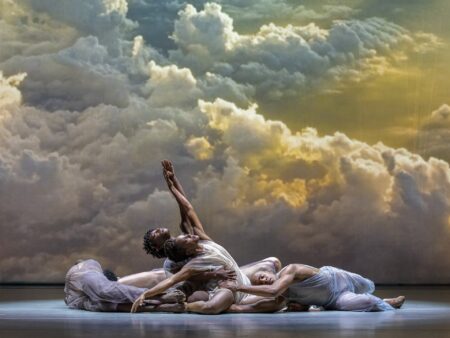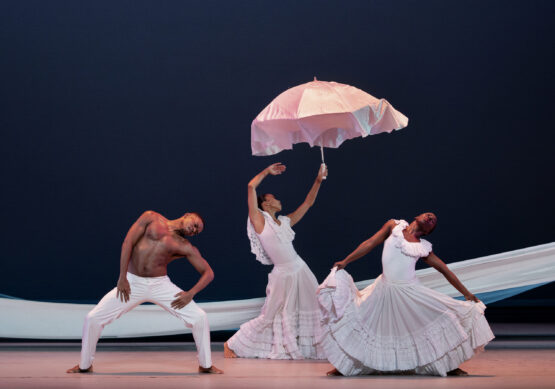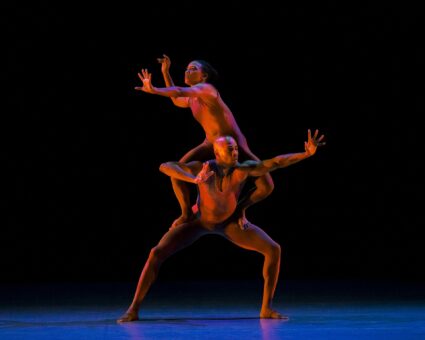 United States Various: Dancers of Alvin Ailey American Dance Theater. Dorothy Chandler Pavilion, Los Angeles, 5.4.2025. (JRo)
United States Various: Dancers of Alvin Ailey American Dance Theater. Dorothy Chandler Pavilion, Los Angeles, 5.4.2025. (JRo)

Sacred Songs
Choreography – Matthew Rushing
Assistant Choreographer – Alexandria Johnson
Creative and Music – Du’Bois A’Keen
Costumes – Danté Baylor
Lighting – Andre A. Vazquez
Sets – Matthew Rushing & Joseph Anthony Gaito
Many Angels
Choreography, Sets – Lar Lubovitch
Assistant Choreographer – Katarzyna Skarpetowska
Music – Gustav Mahler
Costumes – Harriet Jung & Reid Bartelme
Lighting – Clifton Taylor
Treading
Choreography – Elisa Monte
Music – Steve Reich
Costumes – Marisol
Lighting – Clifton Taylor
Original Lighting – Tina Charney
Revelations
Choreography – Alvin Ailey
Music – Traditional spirituals
Décor and Costumes – Ves Harper
Costumes for ‘Rocka My Soul’ – Barbara Forbes
Lighting – Nicola Cernovitch
Alvin Ailey American Dance Theater’s program in Los Angeles was bookended by Matthew Rushing’s Sacred Songs and Alvin Ailey’s beloved and enduring classic, Revelations. The latter never pales, but the former, taking its inspiration from Revelations, never achieved the vividness of its predecessor.

Revelations is a hard act to follow. After sixty-five years in the repertory, it has come to define a version of America and is more familiar worldwide than other American classics: Martha Graham’s Appalachian Spring, Agnes de Mille’s Rodeo, Jerome Robbins’s Fancy Free or George Balanchine’s Stars and Stripes. Revelations is a ballet that lifts the spirits while never ignoring suffering and loss. Though the dance is inextricably tied to African American spirituals and gospel, it transcends the specific to become a universal experience.
Sacred Songs never takes off. Inspired by the spirituals excised from Ailey’s original 1960 version, composer Du’Bois A’Keen reimagines Ailey’s discarded music as a fusion of jazz, gospel and hip hop. What follows is a series of unconnected songs that never cohere into a unified whole. The dancers seem to be at sea: the score’s erratic tempo feels as if it is working at odds with the movement.
Rushing must have struggled with this himself. In order to tie the sections together, he has conceived a repetitive movement: the dancers turn their palms upwards and flap their hands from the wrist, often while bending from the knees and rushing around the stage. It is as if the heat is oppressive, and they need to get the air circulating. From section to section, they fan themselves, only to succeed in drawing attention to the lack of an organic flow to the dance.
Rushing wants his dancers to extract spiritual meaning from the score and the choreography, but the music often fails them. The choreography features chins uplifted, pointing fingers with arms extended and open port-de-bras with arms arcing skywards. At an overlong forty minutes, it has none of Ailey’s sense of drama and timing. Near the end of the piece, however, the dancers gather in rows facing forward and do a skipping jump in place, and the music and the dance finally meld together into an exuberant climax.
Many Angels, recently choreographed by Lar Lubovitch, was premiered by the Ailey company in December of 2024. To Mahler’s Adagietto from Symphony No.5, we enter the sphere of the angels. It is Lubovitch’s response to the question attributed to Thomas Aquinas: ‘How many angels can dance on the head of a pin?’
A pastel-infused, photographic backdrop of clouds places five dancers (Samantha Figgins, James Gilmer, Miranda Quinn, Vernard J. Gilmore and Jesse Obremski) in an otherworldly realm, as does Mahler’s rhapsodic music. Dressed in sheer tunics over bodysuits, the dancers move with heavenly purpose, often anchoring themselves onto each other in elegant lifts and arabesques. Legs are beautifully positioned in attitude and, whether the dancers are kneeling or uplifted, their legs are like angel wings, taking on a solemn grace. After Rushing’s piece, Lubovitch’s ballet was like a whisper of air.

The startling image of dancer Christopher Taylor crouched like a toad in the center of the stage in half-light opened Elisa Monte’s Treading (originally choreographed in 1979 and newly produced in 2024). After the pearlized light of Many Angels, the dim, orange glow of light designed by Tina Charney felt subterranean, redolent of earth and swamp. The stage was dark but for the strategic lighting that illuminated the dancers.
Taylor, in burnished orange leotard and tights, seems to shine from within with a reptilian glow. Still crouching, he pulls Ashley Kaylynn Green forward from behind his body and between his legs, as if giving birth to his mate. They begin their pas-de-deux to Steve Reich’s Music for Eighteen Musicians. We are in a boggy space of insects and amphibians, and the music is redolent of cicadas and crickets.
It was a mesmerizing performance: the dramatic lifts, the tense balancing of bodies, the lizard-like propulsion along the floor.
Revelations – always an AAADT finale and always inspiring – followed, and the company returned to the light of ‘Wade in the Water’ and ‘Rocka My Soul in the Bosom of Abraham’.
Jane Rosenberg